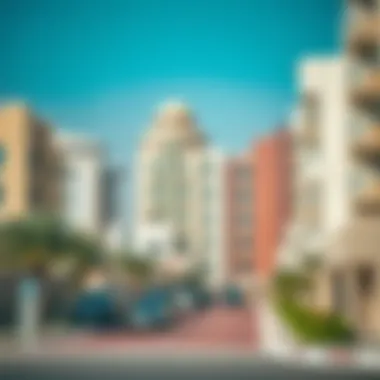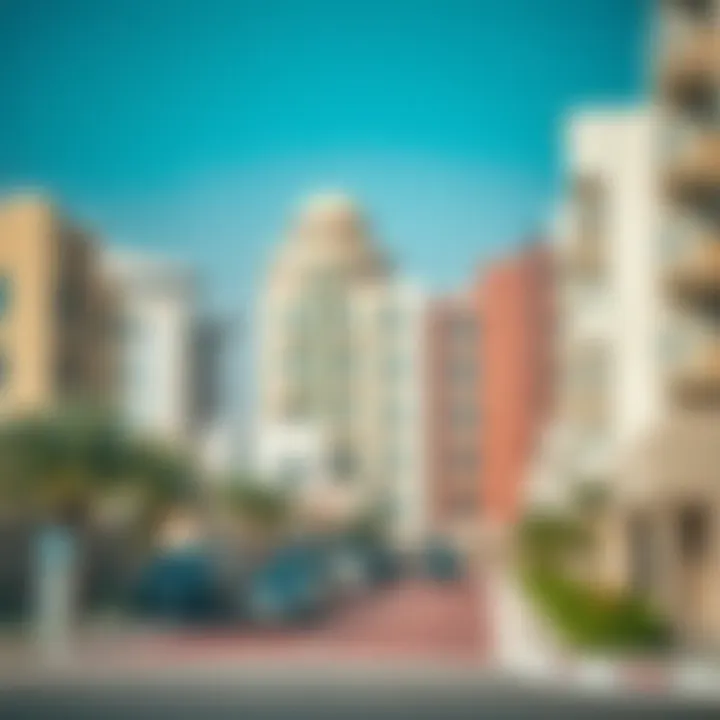Discovering Dubai's Diverse Neighborhoods: A Detailed Guide


Intro
Dubai, a city renowned for its dynamic skyline and luxurious lifestyle, is home to a tapestry of neighborhoods, each offering something unique. Whether you're an investor scouting for promising real estate opportunities or an expatriate looking for a community vibe, understanding the distinct characteristics of these areas is crucial. This guide aims to unveil the multifaceted neighborhoods in Dubai, delving into their essence, real estate possibilities, and communal features. Additionally, it will shine a light on the current market trends, investment strategies, and socio-economic dynamics at play in this vibrant metropolis.
Embarking on this journey, we will explore how various neighborhoods cater to different lifestyles, from bustling urban spots to serene suburbs. One may find it helpful to consider how community amenities, cultural influences, and local landscapes all intertwine to create the fabric of Dubai’s neighborhoods. Investing in real estate isn't merely about property prices; it’s about understanding the neighborhood’s pulse.
Let’s get started.
Preface to Dubai's Neighborhoods
Dubai, a city that embodies modernity and culture, boasts a rich tapestry of neighborhoods, each with its own allure. The neighborhoods of Dubai are not just mere locations—they reflect the lifestyle, aspirations, and socio-economic realities of those who inhabit them. When deciding where to live or invest, understanding the different neighborhoods can significantly impact both quality of life and financial returns.
The Importance of Neighborhood Selection
Choosing the right neighborhood is akin to selecting a jewel from a treasure trove; each offers its own color and sparkle, yet some shine brighter for specific needs. This selection isn't just a choice of scenery—it's a decision that shapes daily experiences and future prospects. Here are several key considerations:
- Lifestyle Compatibility: Every neighborhood caters to certain lifestyles. For instance, a bustling area like Downtown Dubai may appeal to young professionals, while family-oriented communities such as Arabian Ranches offer parks and schools.
- Investment Potential: Investors must weigh potential returns when selecting a neighborhood. Areas undergoing infrastructure improvements or community developments often signal growth, making them attractive for future appreciation in property values.
- Cultural Integration: In a melting pot like Dubai, cultural facets play a significant role in neighborhood life. Understanding these dynamics can facilitate smoother social interactions and enhance overall satisfaction with one's living environment.
"The heart of a community beats strongest in its neighborhoods."
Determining where to plant roots can also affect access to essential services and amenities. Quality schools, healthcare facilities, and leisure options vary from one district to another, influencing not only lifestyle choices but also the resale value of properties. Thus, evaluating neighborhood nuances is crucial for homeowners and investors alike.
As both a vibrant destination for expatriates and a haven for local dwellers, the neighborhoods of Dubai present a complex landscape to navigate. This guide will dissect these neighborhoods, aiding in the discovery of the right fit for you, whether you are seeking a rental, a forever home, or a smart investment.
Dubai's Diverse Neighborhood Landscape
Dubai's neighborhoods are akin to a patchwork quilt, each piece unique yet collectively forming a vibrant tapestry that tells the story of this cosmopolitan city. The significance of understanding this diverse landscape cannot be overstated, especially for investors, homeowners, expatriates, and real estate professionals. Each district in Dubai boasts its own personality, shaped by a blend of cultural influences, architectural styles, and community amenities.
Moreover, as this city continues to evolve, the importance of selecting the right neighborhood for lifestyle and investment becomes paramount. Investors need to know where the hotspots are, homeowners want a place that feels right, and expatriates often seek a community that feels like home. This section will delve into the key districts and cultural influences that shape Dubai’s neighborhoods, spotlighting the factors that make each one distinct.
A Snapshot of Key Districts
When it comes to Dubai, certain neighborhoods stand out like gems in the desert. Each area has its own allure and benefits that cater to different preferences:
- Downtown Dubai: This district is home to the iconic Burj Khalifa and the Dubai Mall. It draws a mix of high-end residents and tourists. The ambiance is exhilarating, filled with entertainment options, luxury boutiques, and fine dining establishments.
- Dubai Marina: An epitome of urban living, Dubai Marina is famous for waterfront residences and a vibrant nightlife. The area is also known for its long promenade, making it popular among joggers and casual strolls.
- Business Bay: Catering to professionals, Business Bay has modern skyscrapers and is a hub for many companies. It offers a convenient work-life balance, with cafes and restaurants lining the waterfront.
- Palm Jumeirah: Known for its luxury villas and posh resorts, Palm Jumeirah offers a unique resident experience with stunning views of the sea. The community vibe is more relaxed, appealing to families and those seeking tranquility.
- Arabian Ranches: This family-friendly neighborhood is designed with spacious homes and lush green landscapes, providing a suburban feel within the bustling metropolis of Dubai.
Each of these districts has its own demographic makeup, lifestyle options, and amenities, which can greatly influence choices for potential investors or new residents.
Cultural Influences on Neighborhoods
Dubai’s neighborhoods don’t just reflect modern architectural designs; they echo the diverse cultures that have made this city their home. The blend of local traditions and international influences gives each neighborhood its own cultural flavor.
- Multicultural Interaction: Living in Dubai means engaging with a mosaic of cultures. Neighborhoods like Jumeirah are preferred by many expatriates due to their familiarity with Western conveniences, while areas like Al Fahidi showcase the more traditional Emirati lifestyle.
- Cultural Events: Many neighborhoods host their own cultural events. For example, markets in Deira and Al Quoz often feature local artisans, promoting Emirati crafts and cuisine. These gatherings help foster a sense of belonging among residents, reinforcing social bonds.
- Architectural Styles: From the ultra-modern design of Dubai Marina to the traditional wind-tower architecture in Bastakiya, the physical layout and style of neighborhoods convey the historical narrative of the region. Each structure often tells a tale of the city’s evolution, showcasing its fusion of past and present.
A keen eye on these cultural influences can provide deeper insights into not only daily life in various districts but also into trends that shape investing and living choices.
“Understanding the cultural nuances of each district can make all the difference when choosing a residence or investment opportunity.”
Market Trends in Dubai Neighborhoods
The real estate landscape in Dubai is constantly evolving. Understanding market trends in Dubai neighborhoods is essential for anyone considering an investment, whether it be a first-time buyer or a seasoned developer. The significance of keeping abreast of these trends cannot be overstated, as they provide insight into the shifting dynamics of supply and demand, property values, and future developments. Investors and homeowners alike need to grasp the pulse of the market to make tactical decisions that could impact their financial futures.
Current Real Estate Climate
The current real estate climate in Dubai exhibits a mix of optimism and caution. With various economic factors in play, such as inflation rates and international investment flows, property investors have to be well-informed. In recent years, certain neighborhoods have experienced a resurgence in popularity. For instance, Downtown Dubai and the Palm Jumeirah have seen substantial growth thanks to their high-profile properties and vibrant community life.
Additionally, there is a noticeable shift towards mixed-use developments that promote a holistic urban experience. This trend is not just about finding a place to live; it's about identifying a lifestyle choice. Properties that offer essential amenities, such as parks, schools, and retail options, are increasingly sought after, resulting in pronounced competition in various sub-markets.
A few notable observations include:
- Sustained demand: Areas that blend residential, commercial, and recreational spaces are gaining traction.
- Investment in infrastructure: Continuous upgrades in transport and public facilities enhance accessibility and overall attractiveness.
- Tech-savvy developments: Smart home features and sustainable practices are becoming selling points that attract both locals and expatriates.
Forecasting Neighborhood Growth
Forecasting growth in neighborhoods is akin to trying to predict the weather; certain trends offer guidance but are often subject to change. However, data-driven analysis allows for a relatively informed prediction of which areas might flourish. A closer look at emerging neighborhoods, such as Jumeirah Village Circle (JVC) and Dubai South, reveals their potential for considerable appreciation in value over time.


Several factors play into this forecasting process:
- Government initiatives: Investment in mega-projects, such as the Expo 2020 legacy, has created a ripple effect on surrounding areas.
- Demographic trends: A rising population, especially among expatriates, prompts an increase in demand for housing, effectively driving up prices.
- Market adaptation: As more individuals seek affordable housing options, areas previously considered less desirable are being renovated and developed for mixed-use.
By analyzing these factors, one can begin to paint a picture of where the market is heading. However, it remains essential for investors to stay flexible, ready to adapt their strategies as the landscape changes.
"Investing in real estate isn’t just about bricks and mortar; it’s about understanding the people and communities that give life to those structures."
Understanding Neighborhood Demographics
Understanding the demographics of neighborhoods in Dubai is crucial for multiple reasons. It forms the backbone of real estate decisions, helping investors, homeowners, and expatriates make informed choices about where to live or invest. Demographics provide valuable insights into the socio-economic fabric of a locality. This explains not only the potential for growth but also influences the lifestyle and amenities available in each area. Knowing who lives in a neighborhood helps in predicting its future value and viability as a residential or investment choice.
Additionally, demographic trends can unveil patterns that might not yet be evident in market statistics. For example, a rising population can signal increased demand for housing, while shifts in age demographics can inform the types of services and infrastructure needed. When looking at neighborhoods, understanding these factors plays a vital role in ensuring that investments match one's lifestyle or business strategy.
Population Trends in Dubai
Population trends in Dubai paint a vivid picture of the city’s growth story. Dubai has been experiencing significant population growth over the past two decades. The population is diverse, mixed with expatriates and locals, resulting in an intercultural environment. According to estimates from Dubai Statistics Center, the population reached nearly 3.5 million people recently, with expatriates making up around 89% of this number.
This vibrant blend creates a rich social tapestry but also presents challenges in terms of resource allocation and community integration. In particular, certain neighborhoods like Jumeirah and Dubai Marina have seen drastic population increases due to their appeal to foreigners seeking modern amenities and luxurious lifestyles. These areas are often bustling hubs full of families, professionals, and tourists.
Understanding these population shifts can help investors identify emerging hotspots. For instance, if an area is becoming home to more young professionals, it could mean a demand for co-working spaces or trendy cafes. Conversely, if there is a surge in families moving into a district, there might be a necessity for schools and playgrounds.
Income and Employment Statistics
Income levels and employment statistics are equally important when examining neighborhood demographics. They not only reflect the economic health of an area but also inform on future investments. For instance, some neighborhoods such as Business Bay and Dubai Internet City have become synonymous with high-income careers thanks to their close proximity to major corporations and business hubs.
Interestingly, the median income levels can vary significantly from one neighborhood to another. Some upscale areas attract professionals with higher salaries, while others may cater to mid-income families or workers in service industries. This income diversity can lead to various housing options available, from luxury villas to affordable apartments, providing choices for different sectors of the population.
Furthermore, looking at employment statistics can also reveal which sectors are thriving. A neighborhood with a high concentration of tech startups may attract young professionals eager to live close to work, further boosting property values in that area.
In summary, the landscape of income and employment in Dubai’s neighborhoods can dictate property trends and buyer behavior. By keeping an eye on these statistics, stakeholders can fine-tune their real estate strategies to align better with future demand. Understanding these numbers can lead to lucrative opportunities in the ever-evolving market of Dubai.
Residential Options in Various Districts
In understanding Dubai's real estate landscape, the choices within different districts stand as pivotal to both lifestyle and investment decisions. Each neighborhood offers varying experiences based on factors like your budget, family structure, and personal preferences. By diving into the residential options available, the potential buyer or renter gains a clearer picture of where they might feel at home, while also considering future value based on market trends.
A variety of options ensures that whether one seeks a luxurious beachfront villa or a cozy apartment in a vibrant community, there’s something for every taste. Let’s explore the specifics you should keep in mind when weighing the many residential districts.
Luxury Living: Palm Jumeirah
Palm Jumeirah is synonymous with opulence, boasting some of the most extravagant residences in Dubai. The man-made island features a range of high-end villas and apartments, many of which provide breathtaking views of the Arabian Gulf. The allure of living in Palm Jumeirah isn’t just in the properties themselves, but in an all-encompassing lifestyle that includes top-notch dining, exclusive beach access, and leisure activities right at your doorstep.
Many families and expatriates flock to this area due to the prestige it carries. That said, prices can be steep, and potential buyers need to weigh their financial options carefully. The sense of community here is fostered by its luxurious amenities and vibrant nightlife, making it ideal for those looking to socialize.
Family-Friendly Areas: Arabian Ranches
For families seeking tranquility without sacrificing quality, Arabian Ranches presents itself as an inviting option. A well-planned community, it features spacious villas nestled amidst greenery, parks, and schools. The atmosphere here is a stark contrast to the hustle and bustle of the city, promoting a lifestyle centered around family and outdoor activities.
This neighborhood stands out for its excellent educational institutions, making it an attractive destination for those with children. It’s not just about space but convenience; grocery stores, healthcare facilities, and recreational areas are all within reach, ensuring that residents don't have to venture too far from home for their daily needs.
Urban Vibes: Downtown Dubai
When one thinks of urban sophistication, Downtown Dubai is hard to beat. As a bustling hub of activity, it features contemporary living arrangements ranging from stylish apartments in the Burj Khalifa to chic loft units in the surrounding towers. The vibrant lifestyle here is complemented by a host of shopping, dining, and entertainment options, ensuring that there's never a dull moment.
Living in this district means being at the heart of Dubai's cultural and economic life. Residents can easily enjoy events at Dubai Opera or stroll through the iconic Dubai Mall. However, it’s worth noting that such a prime location comes at a premium, making it essential for potential residents to consider the associated costs.
"A keen understanding of these neighborhoods aids in making an informed decision that resonates with both lifestyle and investment dreams."
With varied residential options throughout Dubai, it becomes crucial for investors, expatriates, homeowners, and agents to carefully assess each district's unique offerings and implications. Whether choosing a luxurious lifestyle in Palm Jumeirah, a family-friendly haven in Arabian Ranches, or the urban excitement of Downtown Dubai, the choice ultimately hinges on personal preference balanced with financial wisdom.
Community Amenities and Services
Understanding community amenities and services is paramount for anyone navigating life in Dubai. These elements shape the living experience within the varied neighborhoods of this cosmopolitan city. From schools to hospitals and parks, amenities not only enhance quality of life but also dramatically impact property values. When considering relocation or investment, the amenities available can make or break a decision.
Educational Institutions


Education is one of the cornerstones of a thriving community. Dubai boasts a rich tapestry of educational institutions, catering to diverse populations and cultures. Parents can find schools that follow various curriculums—British, American, Indian, and more.
- International School of Arts and Sciences: a favorite among expats, it provides a multicultural environment.
- GEMS Education: renowned for its quality across several campuses, offering an excellent education.
Additionally, higher education institutions like the University of Wollongong and Khalifa University offer specialized programs that attract both local and international students. Accessible educational options enhance neighborhood desirability and, consequently, property prices, making it essential for investors and families alike to consider nearby schools when choosing a location.
Healthcare Facilities
The availability of healthcare services is a pivotal factor in neighborhood appeal. Dubai has made significant strides in this area, showcasing state-of-the-art hospitals and clinics. Facilities like Dubai Healthcare City house over 120 medical institutions, ranging from specialist centers to advanced hospitals. Main hospitals include:
- Cleveland Clinic Abu Dhabi: well-known for its exceptional cardiac care.
- Mediclinic City Hospital: offers a range of specialties under one roof.
For residents, proximity to quality healthcare not only ensures peace of mind but can also influence market trends. A community with robust healthcare services typically attracts families and retirees, contributing to stability in property values. In investment terms, this can be a gold mine.
Recreational Spaces
Life in Dubai isn’t just about work and family; recreational spaces play a crucial role in fostering social interactions and promoting wellness. Parks, beaches, and sports facilities form the backbone of leisure activities. Notable mentions include:
- Al Barsha Park: a green oasis perfect for families, featuring playgrounds and jogging paths.
- Jumeirah Beach: combining relaxation and activity, it offers beachfront access and water sports.
- Dubai Sports City: an ambitious project dedicated to promoting sports culture, featuring stadiums, golf courses, and sports academies.
These spaces give residents opportunities to unwind and socialize, slowly weaving a sense of community. Investors recognize areas with ample recreational options typically experience increased interest, making these parks and sports facilities a vital consideration.
In summary, when evaluating neighborhoods in Dubai, the examination of community amenities and services is essential. They not only contribute to an improved living experience but also hold significant weight in real estate investments. A well-equipped location leads to a flourishing community, attracting families and professionals alike.
In the end, whether you're a homeowner, investor, or expatriate, understanding the available amenities will guide you in making informed decisions that align with your lifestyle or investment strategy.
Transportation and Connectivity
Transportation and connectivity play a crucial role in shaping the dynamics of neighborhoods in Dubai. As a city on the rise, the ease of movement within and outside of districts significantly affects real estate values, daily commuting, and overall quality of life for residents. This section sheds light on how the various forms of transportation infrastructure contribute to the vibrancy and desirability of these neighborhoods.
Public Transport Infrastructure
Dubai's public transport system is quite comprehensive, offering residents various forms of commuting options including buses, metros, taxis, and even water taxis. The Dubai Metro, for instance, is a crown jewel of the city's transit network. Operated entirely on a driverless system, it connects multiple neighborhoods efficiently and often within minutes.
- Metro Lines and Stations: Key metro stations such as Dubai Mall, Burj Khalifa, and Mall of the Emirates provide easy access to some of the city’s top attractions and pivotal business districts. These services run frequently, ensuring minimal wait times during peak hours.
- Bus Services: The bus network complements the metro system, covering areas that may not be served directly by train. Buses are fully air-conditioned and are pinpointed by a user-friendly app for route planning, making them an attractive choice for many.
- Water Transport: For those living near the waterfront, the water taxis and abras add a scenic touch to the daily commute. It's more than just a mode of transport; it’s an experience that offers stunning views of the cityscape.
"Accessibility via public transport elevates a neighborhood's profile, drawing in both expats and local families alike."
Accessibility to Key Locations
Understanding how easily one can reach key locations from different neighborhoods is equally important. Dubai's layout, with major commercial areas, educational institutions, and healthcare facilities, influences people's choice of where to live.
- Proximity to Business Hubs: Areas like Dubai Internet City and Dubai Media City are directly connected by major roads and public transport links. Residents commuting to work can save precious time, which in turn increases the desirability of neighborhoods.
- Recreation and Lifestyle Access: Regions such as Jumeirah and Downtown Dubai are in close proximity to parks, beaches, and leisure facilities. Accessibility adds a layer of convenience, allowing residents to enjoy social activities and recreational options without extensive travel.
- Educational Institutions: Neighborhoods that host reputable schools and universities naturally attract families. Areas like Arabian Ranches and Jumeirah benefit from this, creating a family-friendly atmosphere that’s ideal for settling down.
Cultural and Social Dynamics
The neighborhood landscape of Dubai is not just about concrete structures and glass facades; it's also rich in cultural and social dynamics that shape the experience of living in this bustling city. Understanding these dynamics offers invaluable insights for investors, homeowners, and expatriates looking to move into the area. A neighborhood's character is often defined by its social fabric, which includes community involvement, local events, and the inclusive nature of its residents.
Community Involvement and Events
Community involvement is a cornerstone of Dubai's neighborhoods, allowing residents to forge connections and foster a sense of belonging. From local clean-up initiatives to cultural festivals, these events serve as a platform for residents to engage with one another, regardless of their backgrounds. For example, the Dubai Shopping Festival brings together people from all walks of life, showcasing local talents, artisans, and businesses.
- Benefits of Community Involvement:
- Building Relationships: Active participation in neighborhood events can help you make friends and connect with your neighbors, creating a support network.
- Enhancing Local Culture: Engaging in cultural events increases awareness of diverse traditions, enriching the community's cultural tapestry.
- Increasing Property Value: Neighborhoods with active community organizations often see higher property values as they become more desirable places to live.
Moreover, social clubs, sports leagues, and art collectives also play critical roles in nurturing community spirit. The Dubai Opera, for instance, frequently hosts community events where local artists perform, promoting a sense of pride in local talent.
Social Networks and Expats
In a cosmopolitan city like Dubai, social networks among expatriates are particularly vital. The melting pot of nationalities creates a unique environment for building connections. Many expats find it helpful to join social media groups or online forums—such as those on Facebook or Reddit—dedicated to expatriate life in Dubai. This provides newcomers with access to advice, friendships, and even professional opportunities.
For expats, understanding how to navigate these social networks can significantly ease the transition into their new neighborhoods. Participating in community events often leads to richer social interactions and networking opportunities.
- Key Aspects of Social Networks Among Expats:


- Support System: Establishing connections with fellow expatriates can provide emotional support, helping to alleviate homesickness.
- Cultural Exchange: Exchanging experiences and traditions allows individuals to appreciate their unique backgrounds while integrating into the local culture.
- Professional Connections: Many expats find job opportunities through networking, as word-of-mouth recommendations are often how roles get filled in Dubai's competitive job market.
"Community ties and social networks are not just 'nice to have'; they are essential for thriving in Dubai's multifaceted neighborhoods."
Economic Considerations
In any discussion about real estate, the economic considerations of the area play a crucial role. For potential investors, homeowners, and even expatriates looking at Dubai's neighborhoods, understanding the economic landscape isn't just an added bonus; it's essential. Economic factors can dictate everything from property values to community amenities, and they can ultimately influence the quality of life experienced by residents.
Investment Opportunities
When we talk about investment opportunities in Dubai, there’s more than meets the eye. The emirate is known for offering a diverse range of properties, located in various neighborhoods that cater to different lifestyles and preferences. Here are a few key points to consider:
- Emerging districts, like Dubai Hills Estate, have been gaining traction; savvy investors are noticing the slope of upward potential in housing prices.
- Luxurious options in places such as Downtown Dubai and Palm Jumeirah have become synonymous with high returns on investment. The potential for capital appreciation is high in these sought-after locales.
- Lower entry points in suburban areas can be appealing for those looking to enter the market without breaking the bank. Neighborhoods like Dubai Investments Park are where one can find residential units at more approachable prices, giving investors a foothold in the city.
These varied options mean that there’s no shortage of chances to invest wisely, reflecting both personal taste and financial strategy. Moreover, Dubai's favorable tax environment makes it even more enticing, allowing investors to reap a greater reward as profits align with reduced tax liabilities.
Property Value Trends
Understanding property value trends is another crucial element for anyone considering a move to Dubai or investing in the real estate market. Keeping an eye on these fluctuations can save investors both time and money.
- The trend indicators show that property values in Dubai often rise in accordance with infrastructural developments. Expansion of the metro system, new malls, or even parks can significantly boost nearby property values.
- Additionally, the market has seen resilience even during global downturns—a testament to Dubai's unique position as a commercial hub. Investors take note: while economic conditions in other parts of the world may lead to stagnation, Dubai often remains buoyant.
- Areas with a high influx of expatriates typically experience sharper growth in property values, particularly in neighborhoods like Jumeirah Lakes Towers (JLT) and Business Bay, where a vibrant community atmosphere helps drive demand.
In a city where the skyline is constantly evolving, the discerning investor must keep their finger on the pulse of economic trends to foresee the next opportunity.
Regulatory Environment
Understanding the regulatory environment in Dubai is essential for anyone considering property investment in this dynamic city. The legal framework not only shapes the possibilities for real estate but also influences the stability and attractiveness of neighborhoods. Potential homeowners and investors need to be aware of the regulations that govern property ownership, sales, and leasing, as these can significantly affect both the ease of doing business and the long-term return on investment.
One of the cornerstone principles of real estate in Dubai is the clarity that comes with its laws. This isn’t just legal jargon; it's what sets the stage for a well-structured market. Investors, especially foreigners, require a clear understanding of property laws to make informed choices. This segment delves into vital regulations that impact both residential and commercial real estate landscapes in this emirate.
"Legal clarity fosters confidence—if you know the rules of the game, you can play it effectively."
Real Estate Laws in Dubai
The first layer of the regulatory framework resides with the real estate laws in Dubai, most notably influenced by the Real Estate Regulatory Agency (RERA). Established as part of the Dubai Land Department, RERA is pivotal in setting guidelines for property ownership and transactional processes. For many, this means having access to clear documentation, which adds an essential layer of security and oversight.
One must consider several key aspects of these laws:
- Freehold vs. Leasehold: Not all properties in Dubai are freehold, which permits full ownership for expatriates. Certain developments are leasehold, meaning that foreign buyers can secure a property for a specified period.
- Registration: All property transactions must be registered with RERA. This process ensures transparency and protects the rights of both the buyer and the seller.
- Dispute Resolution: Special courts exist to resolve real estate disputes, offering a clear path for addressing grievances without lengthy legal battles.
For any investor, grasping these concepts is essential; they lay the groundwork for a secure investment journey.
Foreign Ownership Regulations
The regulations around foreign ownership play a critical role in attracting international investors. In Dubai, expatriates can own property in designated areas, commonly referred to as freehold areas. However, comprehending the nitty-gritty of these regulations is crucial.
Key points to note include:
- Percentage Ownership: Foreigners can generally own up to 100% of a property within these designated areas, which includes popular locales like Dubai Marina and Downtown Dubai.
- Investment Requirements: Certain areas may require a minimum investment amount to qualify for ownership, essentially functioning as a barrier for casual buyers, but enhancing the quality of investments.
- Residency Visa: Owning property in Dubai can pave the way for a residency visa, contingent on meeting specific criteria. This is particularly appealing for expatriates wishing to establish long-term roots.
Navigating these regulations not only helps in making informed investments but also in assessing the potential returns and risks associated with property ownership. With the right knowledge, investors can leverage the opportunities Dubai offers within its vibrant neighborhoods.
Ending
In the dynamic landscape of Dubai, understanding the intricacies of its neighborhoods is not just a matter of preference, but a pivotal factor in making informed real estate decisions. This article has furnished readers with a broad overview of various districts, enabling potential homeowners, investors, and expatriates to grasp the multifaceted nature of Dubai’s housing market. The significance of neighborhood selection extends beyond personal comfort; it influences property values, investment potential, and overall lifestyle satisfaction.
Summary of Key Insights
Throughout the exploration of Dubai's neighborhoods, several key insights emerge:
- Diverse Options: From the luxury villas of Palm Jumeirah to the family-friendly homes in Arabian Ranches, Dubai offers a broad spectrum of residential choices that cater to varying lifestyles and budgets.
- Cultural Influence: The diverse cultural backgrounds of residents shape community vibes, evident in local markets and social events that enrich neighborhood life.
- Market Trends: Keeping abreast of the real estate climate and understanding population and economic trends can empower investors to make strategic moves. Current trends point to robust growth in designated areas, bolstered by ongoing infrastructural developments.
- Accessibility: Public transport options like the Metro and various bus services enhance connectivity, offering residents convenience and ease of commuting across the city.
By distilling these insights, the article aims to empower readers in their quest for not just a house, but a thriving community.
Future Outlook
Looking forward, Dubai’s neighborhoods are poised for evolution. With the city's ongoing investments in infrastructure and community amenities, the appeal of certain districts is set to grow. The anticipated projects under Dubai's 2040 Urban Master Plan are likely to reshape existing neighborhoods and develop emerging ones, presenting opportunities for savvy investors.
As tourism continues to rebound and the expatriate community flourishes, neighborhoods that embrace diversity and community engagement will likely thrive. Areas previously viewed as up-and-coming may become attractive for long-term investments, especially those that prioritize sustainability and modern living.
In short, the future of Dubai’s neighborhoods is bright, reflecting the city’s resilience and capacity for adaptation. Whether you are a potential homeowner, investor, or someone simply curious about this vibrant metropolis, staying informed about neighborhood dynamics will remain essential in navigating this fascinating landscape.
"The future belongs to those who believe in the beauty of their dreams." — Eleanor Roosevelt
A fitting reminder for anyone considering a new chapter in their lives within Dubai.



